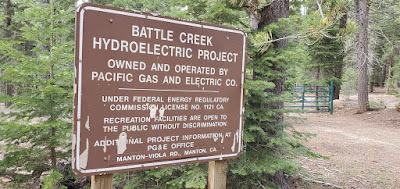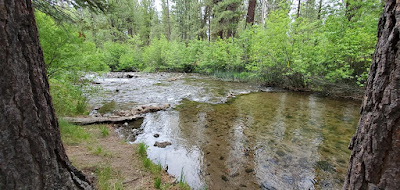
We visited Oakland, California on 3/31/19 during a weekend camping trip to the South Bay
Area. Lake Merritt is a 155 acre large
tidal lagoon located at an elevation of 43 feet above sea level in the center
of Oakland, California, just east of Downtown. It is surrounded by parkland and
city neighborhoods. It is historically significant as the United States' first
official wildlife refuge, designated in 1870, and has been listed as a National
Historic Landmark since 1963, and on the National Register of Historic Places
since 1966. The lake features grassy shores; several artificial islands
intended as bird refuges; an interpretive center called the Rotary Nature
Center; a boating center where sailboats, canoes and rowboats can be rented and
classes are held; and a fairy tale themed amusement park called Children's
Fairyland. A popular 3.4 mile walking
and jogging path runs along its perimeter.
The lake was originally an arm of the San Francisco Bay formed where
several creeks empty into the bay. It was surrounded by 1,000 acres of wetlands when the Ohlone people fished,
hunted and gathered food along its shores. By 1810, the remaining Native
Americans were removed to Mission San José and the estuary and 44,800
acres of surrounding land was deeded to
Sergeant Luis Maria Peralta to become Rancho San Antonio. After gold was discovered
in 1848 in present-day Coloma 125 miles
to the northeast, Anglo squatters led by lawyer Horace Carpentier took
control of the East Bay area which was to become downtown Oakland, including
the estuary known as "San Antonio Slough." In 1856, Peralta fought
and won a United States Supreme Court case against the squatters but further
court cases between his sons and daughters would greatly diminish their
holdings. The Peralta brothers had to sell much of the land to Carpentier to
pay legal fees and new property taxes. Oakland was incorporated in 1852 with
Carpentier as its first mayor and the estuary became the city's sewer.
Lake Merritt naturally had tidal flows via a broad 600 foot outlet, but
this has been steadily reduced with development of the region after 1869.
Currently the tidal flows are limited in size and managed for flood
control. For years the lake acted as a
waste collector. It was regarded as ideal for sewage because of its chemical
contents, which have high acidities that cause it to decompose human feces at
very high rates. Sixty miles of brick and wood channeling sent the broken down
sewage to the bottom of the lake to then be eaten by bottom feeders. The stench
at the lake during the decomposition of the sewage was a problem for Oaklanders
on the west shore and residents of Clinton and San Antonio villages on the
east.
Dr. Samuel Merritt, a mayor of Oakland who owned property at the shore's
edge, was keen to get the body of water cleaned up so that it could become a
source of civic pride. In 1868, he proposed and funded a dam between the
estuary and the bay by which the flow of water could be controlled, allowing
the water level inland to rise higher and become less saline, turning the tidal
lagoon into a lake. Sewage was to be redirected elsewhere by two new city
projects, though these weren't completed until 1875. The resulting body of
water was called variously "Lake Peralta", "Merritt's Lake"
and later Lake Merritt.
The lake at that time still had thick wetlands fringing the shores and it
continued to attract large numbers of migratory birds. In order to protect the
birds from duck hunters and stop the noise and danger of gunfire so close to
the city, Dr. Merritt proposed to turn the lake into a wildlife refuge in 1869.
The state legislature voted Lake Merritt Wildlife Refuge into law in 1870,
making it the first such refuge in North America. No hunting of any sort was to
be allowed and the only fishing was to be by hook and line.
The Camron-Stanford House was built by Samuel Merritt in 1876 along the
southwest corner of Lake Merritt in Oakland, California. The ornate Camron-Stanford House was built in 1876 near the lake's
western shore. Tax records suggest that Samuel Merritt built the Italianate
Victorian as part of his plan to promote and develop downtown Oakland and the new
lake. In 1877, the house's title was transferred to Mrs. Alice Camron, a
purchase she was able to make due to an inheritance from her father, California
pioneer Dr. John Marsh. She, her husband Will and their two daughters were the
first residents of the home. Further fine homes were built on the lakeshore by
others following Dr. Merritt's lead, though none but Camron-Stanford remain
today. Beginning in 1910, the house served as the Oakland Public Museum. In
1967, the Oakland Museum moved to other quarters, and the Camron-Stanford House
is now a separate museum.
Protection for the wetlands was nonexistent and residences kept being
built on reclaimed land around the shore of the lake. Cleanliness continued to
be a problem because of incomplete sewage projects and the lake kept silting up
since the natural tidal flow had been interrupted by Merritt's dam. Dredging of
the lake began in 1891, with the removed silt being piled along the eastern
shore to make a foundation for a road which became Lakeshore Avenue.
From 1893 to 1915, Lake Merritt saw major changes. Inspired by the new
City Beautiful movement which got its start at the World's Columbian Exposition
(Chicago World's Fair), the lake became a city-owned park. In 1913 an elaborate
Mission Revival pergola was constructed at the northeastern tip of the lake.
Adam's Point was cleared of houses, planted with lawns and imported trees and
became Lakeside Park. Eastshore Park was created where East 18th Street brought
Trestle Glen's watershed to the lake. Oakland Civic Auditorium was built at the
south edge of the lake in 1914.
Lake Merritt's natural wetlands are long gone—converted to parks,
pathways and roads. Some of the wetland vegetation has been restored to five
"Bird Islands" constructed of dredged silt between 1925 and 1956;
islands which shelter hundreds of nesting and roosting water fowl. The islands
have a fresh water irrigation system to bring drinking water to the birds. A
boom and a rope/buoy barrier protects the islands from recreational
boaters.[14]
Under the name Lake Merritt Wild Duck Refuge, the site became a National
Historic Landmark on May 23, 1963.
Children's Fairyland is a 10-acre park designed by William Russell
Everett, and built in 1950 in Lakeside Park. When Walt Disney was planning
Disneyland, he visited Children's Fairyland for ideas.
A "necklace of lights" encircles Lake Merritt. Featuring 126
lampposts and 3,400 "pearly bulbs", the necklace was first lit in
1925. In 1941, the lights were removed to comply with World War II blackout
conditions. After a decade-long campaign by the Lake Merritt Breakfast Club,
the lights were again illuminated in 1987.
During
Oakland's annual gay pride celebration, the city replaces the white bulbs with
multicolored bulbs.



















